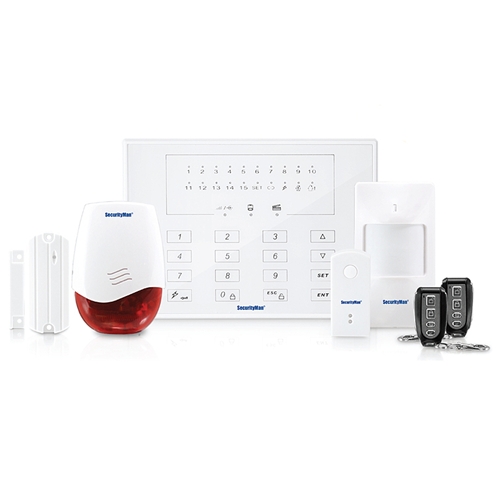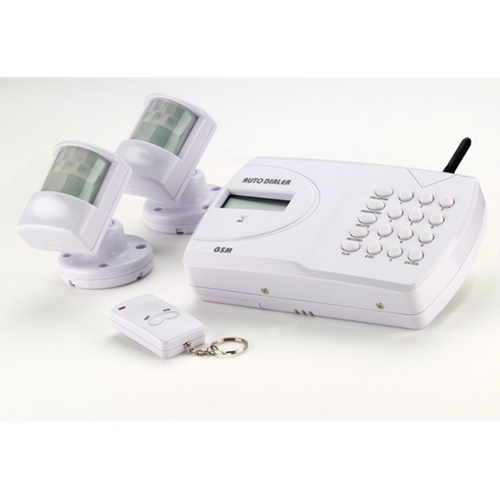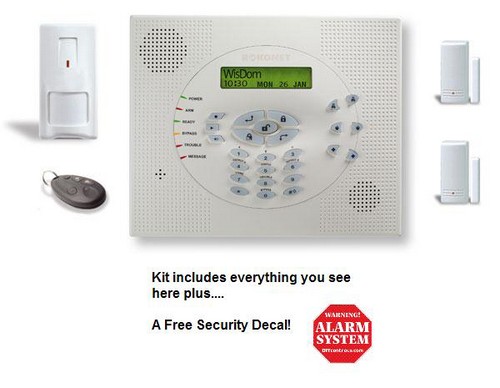A home security system is a smart way to protect your home and property, and a wireless DIY home security system has many advantages compared to a dealer-installed hard-wired system. Home invasions are a real threat — according to the FBI, there were over 1,900,000 burglaries in the United States in 2010, of which 73.9% are associated with residential properties. If you are beginning to shop around for a home security system, here are some good reasons to pick a wireless DIY system:
1. Â Less Expensive
Today’s wireless DIY home security systems give you state-of-the-art technology at incredibly affordable prices. For instance, a complete “starter kit†like the Skylink SC-10 — which includes a control panel and two sensors – can be purchased for under $100. More advanced systems such as the feature-rich WisDom Wireless series, which come with additional sensors and can be programmed for multiple zones and partitions, start at $199.
In comparison, a dealer-installed hard-wired alarm system averages $1,500 for a 2,000-square-foot home (depending on the equipment and layout of your home), plus monthly monitoring fees that may range from $29.95 to $41.95.
2. Â Easy to Install
A wireless DIY home security system communicates via radio signals, making it much easier to install than a hard-wired alarm system which requires running wires and drilling holes through walls, ceilings, woodwork and concrete. In older homes that are difficult to wire because of their layout or construction, a wireless system is an attractive solution. Do-it-yourselfers can install most wireless systems in just a few hours.
3. Â Tamper Resistant
A skilled burglar will attempt to disarm a traditional home alarm system by cutting wires. But sabotaging a wireless home security system is not nearly as easy since each wireless component operates independently and would have to be disabled individually.
4. Â Continues to Operate During Power Outages
Because every sensor in a wireless DIY home security system is battery powered, sensors continue to operate even during power outages. Some systems use long-lasting lithium batteries that provide 3 to 5 years of service. The control panel of a wireless security system usually uses A/C power, but it’s reliable, robust backup batteries keep the system operating should the A/C power fail.
 5. Â Protects Against Intrusion and Environmental Disasters
5. Â Protects Against Intrusion and Environmental Disasters
Today’s wireless DIY home security systems are expandable so you can add a variety of sensor options and accessories, including motion sensors, flood sensors, door/window sensors, smoke detectors, keychain remote controls and glass breaker sensors.
The easy-to-install Security Man Air-Alarm II with Doorbell is an example of an affordable DIY home security system that can be upgraded easily by adding up to 60 wireless sensors, sirens, and up to 10 remote controllers. The basic kit costs $139.99 and additional sensors can be added for about $20.00 each.
6. Â Eliminates the Expense of an Outside Monitoring Service
Wireless DIY home security systems are designed to contact you directly when there is an emergency, instead of being routed through a costly outside monitoring company. Many wireless DIY home security systems can be programmed to dial multiple phone numbers, so if your first family member doesn’t answer the phone, another person is called automatically.
 7. Â Works Without a Landline Connection
7. Â Works Without a Landline Connection
Many wireless DIY home security systems now offer a cellular communications option, making them ideal for homes without a landline phone. You can also add a cellular terminal as a backup so if your landline connection is cut, your wireless home alarm can still send out alerts.
8. Â Troubleshooting is Easy
Locating a problem within a hard-wired system can be very difficult and require a professional to analyze the hundreds of feet of wiring. Many wireless alarm systems do their own troubleshooting and identify the problem component. In addition, most wireless sensors provide “low battery†alerts so you’ll know exactly when it’s time to replace the battery.
9. Â Take it With You
It’s simple to disconnect the control panel and sensors of your DIY home security system. If you move, you can take your wireless security system with you and install it in your new home.
10. Â Use as a Home Automation Center
Some DIY home security systems also double as a “home automation center†that allows you to remotely control household appliances and lights, even when you are away from home. And since your wireless DIY home security system is expandable, you can add sensors at any time.





Derek
A lot of DIY systems dont allow central monitoring, instead sending a pre-recorded message to you phone. This forces you to go to your home and put yourself into harms way. Check out http://simplisafe.com for an inexpensive DIY home security system with central monitoring for only $14.99 a month, with no contract!
admin
True, many DIY systems do not allow central monitoring, however, there are other DIY units like the WisDom Wireless that give you the option of contracting with an outside service. Regardless of which approach you choose –central monitoring or receiving alerts directly by phone, text or email message — homeowners should NEVER put themselves in harms way by responding directly to an alarm alert! Always contact your local police department first and have a law enforcement officer check out the situation before entering your home.
Pingback: Why Fall is a Good Time to Address Home Security